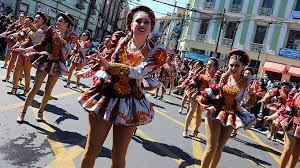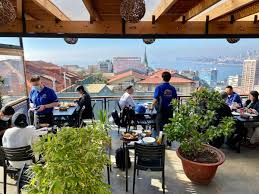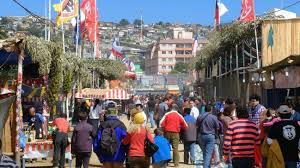What are the key cultural symbols of Valparaíso?

What are the key cultural symbols of Valparaíso?
What are the key cultural symbols of Valparaíso? Valparaíso, Chile’s colorful and eclectic port city, is a place where culture, history, and creativity converge.
With its bohemian spirit, iconic landmarks, and vibrant arts scene, Valparaíso stands out as one of the most unique cities in Chile.
Cultural symbols are woven into the fabric of the city, reflecting its rich heritage, maritime history, and the resilience of its people. Here’s a look at the key cultural symbols that define Valparaíso.
The Funiculars: Steeped in History
One of the most iconic symbols of Valparaíso is its funiculars. These elevators were originally built in the late 19th and early 20th centuries to transport residents and goods up the city’s steep hills.
The funiculars are not only practical but have become part of the city’s identity, offering picturesque views of the harbor, hills, and historic buildings.
They’re also a reminder of the city’s maritime and industrial past, when it was a major port of entry in South America.
Some of the most famous funiculars include the El Peral, Artillería, and Cerro Concepción funiculars. Each of these rides offers a glimpse into Valparaíso’s history and a unique way to experience the city.
Colorful Houses: The Soul of the City
The vibrant, multi-colored houses that dot the hills of Valparaíso are another defining cultural symbol. The cliffs and hillsides are covered in houses painted in a spectrum of colors—red, yellow, purple, blue, green—creating a patchwork quilt across the city.
These houses, often built with wooden materials and constructed with little regard for uniformity, reflect the spontaneity and creativity that Valparaíso is known for.
Over time, the colors have become not just a decorative feature but also a form of expression, symbolizing the city’s artistic freedom.
In many ways, the colorful houses represent Valparaíso’s resilience. They were constructed during a time of rapid growth, reflecting the working-class roots of the city while adapting to the rugged geography of the coastal hills.
Street Art and Murals: A Living Canvas
Valparaíso is internationally recognized for its vibrant street art scene. The city’s walls are adorned with stunning murals, graffiti, and urban art, which have transformed Valparaíso into an open-air gallery.
Street art here is not only a form of artistic expression but also a reflection of the city’s social and political history. Over the years, murals have served as a medium for activism, identity, and cultural commentary.
The Cerro Alegre and Cerro Concepción neighborhoods are particularly known for their murals, with artists using the city’s walls to communicate stories of the working-class struggles, political movements, and local pride.
This art has become a major part of the city’s cultural fabric, contributing to its bohemian vibe and cultural tourism.
The Harbor: The Heart of Valparaíso
The harbor is at the core of Valparaíso’s identity and history. The city’s strategic location on the Pacific Ocean made it a vital port for trade and shipping, particularly during the 19th century, when Valparaíso was one of the busiest ports in the world.
Today, the harbor continues to play an important role in the local economy and culture. It is not just a site of commercial activity but also a symbol of the city’s global connections, maritime heritage, and resilience.
The iconic lighthouse at the entrance of the port is another significant symbol, representing guidance, hope, and navigation for both sailors and locals alike.
For many, the harbor is a place of nostalgia, connecting the past with the present. Whether viewed from the Cerro Alegre or from a boat cruise, the harbor remains central to Valparaíso’s identity.
The Ascensores: Steeped in Tradition
In addition to the funiculars, ascensores (elevators) are another iconic feature of Valparaíso’s landscape. These mechanical systems were originally designed to help people scale the city’s steep hills, particularly in the late 19th and early 20th centuries.
The ascensores are a reminder of Valparaíso’s industrial past and are an important part of its urban fabric.
Today, there are 16 ascensores remaining in the city, several of which are still in operation. Some of the most famous are the Ascensor Reina Victoria and Ascensor Concepción.
The ascensores represent the city’s innovation in overcoming its geographical challenges, and riding one is a must for visitors wanting to experience the city’s unique topography.
The Chilean Navy: A Legacy of Maritime Power
The Chilean Navy has deep roots in Valparaíso, which served as the naval base and headquarters for Chile’s maritime forces for many decades. The city’s relationship with the sea has been central to its identity and history.
Valparaíso is home to the Museo Marítimo Nacional (National Maritime Museum), which showcases the city’s rich maritime heritage.
Here, visitors can learn about the role of the navy in shaping Chile’s history, as well as the battles, explorations, and traditions tied to the sea.
Valparaíso’s naval heritage is also reflected in its military monuments, such as the Monumento a los Héroes de Iquique, which honors Chilean naval heroes who fought in key battles, including the Battle of Iquique.
The Plaza Sotomayor: Heart of the City
The Plaza Sotomayor is another central symbol of Valparaíso’s cultural identity. This bustling square, located at the entrance to the port, is home to the Monumento a los Héroes de Iquique and is surrounded by some of the most important buildings in the city.
The square marks the convergence of the city’s maritime history with its modern-day urban life. It’s a site for commemorative events, festivals, and a meeting point for both locals and visitors.
The plaza’s mix of neoclassical architecture and historical monuments highlights Valparaíso’s blend of old-world charm and modern vitality, making it one of the most important public spaces in the city.
A City of Symbols
Valparaíso’s key cultural symbols are intertwined with its history, art, and spirit.
Each of these symbols represents an essential piece of what makes Valparaíso one of the most unique and beloved cities in Chile.
Whether you’re strolling the hills, visiting the harbor, or enjoying the city’s murals, you are connecting with its rich and vibrant cultural heritage.





Leave a Reply